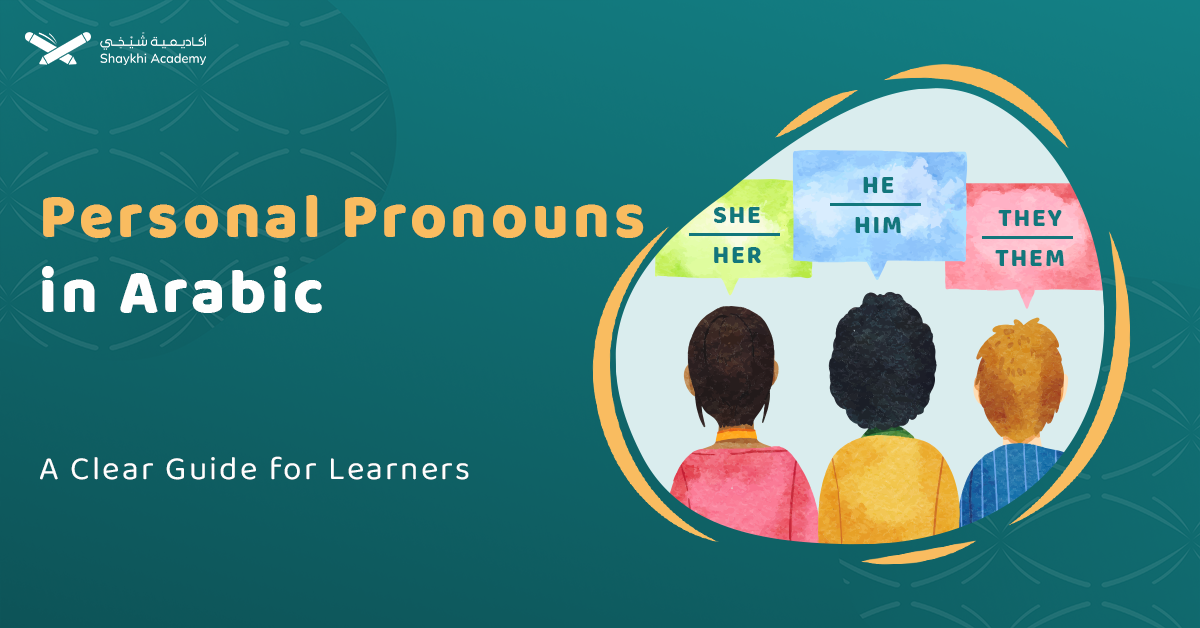Personal pronouns in Arabic are essential for communication, changing based on gender, number, and syntactic role in sentences. They serve to avoid repetition, clarify gender and number, and enhance sentence clarity, with detailed functions across various cases like subjective, possessive, and objective forms.
Personal pronouns are among the first vocabulary elements encountered by learners of foreign languages. Personal pronouns in Arabic are very accurate. They change according to gender, number, and role in the conversation.
Let’s dive into this important title and comprehend many details about Arabic personal pronouns including their function, characteristics, and uses.
Personal Pronouns in Arabic
Personal pronouns in Arabic are pronouns that refer to a person. These persons are divided according to their role in conversation into 14 cases. These cases will result in more than 14 pronouns. Since each case has more than 1 pronoun according to their grammatical case which depends on their syntactic position. Here is a detailed explanation of the three main conversational roles with their main subdivisions.
It is noteworthy that these pronouns are pronounced differently according to the dialect. If you need to target Jordan, Syria, Lebanon, or Palestine dialects, you can join our Levantine Arabic classes.
1. First person Pronouns “the speaker”
This partition of pronouns is called in Arabic Al-mutakallim which means the speaker. It will be further subdivided into two main cases. Each case has 5 pronouns according to their number and their grammatical case. This table will explain all these types.
| Case | Subjective detached as a subject of nominative sentence | Subjective “Attached to a verb in the past tense. | possessive “Attached to a noun or a preposition | Objective detached | Objective attached to a verb to clarify the object |
| Singular first person | أنا= ana | تُIt’s called “Tā’ al-Fā‘il” (تاء الفاعل), which means “the Tā’ of the subject. | ي For example: my pen قلمي | إياي | نيFor example: You called meكلمتني |
| Pleural first person | نحن= nahno | نا It’s called نا الفاعلين (Nā al-Fā‘ilīn), which means “the (Nā )of the pleural subject. | ناFor example: our penقلمنا | أيانا | نا For example:You called us كلمتنا |
2. Second person Pronouns “the person you speak to”
The second partition of pronouns is called in Arabic Al-mukhāṭab which means a present person or persons when you address them. It will be further subdivided into six main cases. Each case has 5 pronouns according to their number and their grammatical case. This table will explain all these types.
| Case | Subjective detached as a subject of nominative sentence | Subjective “Attached to a verb in the past tense. | possessive “Attached to a noun or a preposition | Objective detached | Objective attached to a verb to clarify the object |
| Singular masculine second-person | أنتَAnta | تَ For example: you read the book قرأت الكتاب | كَFor example: your penقلمكَ | إياكَ | كًFor example, I called you كلمتكَ |
| Singular feminine second-person | أنتِAnti | تِFor example:You read the bookقرأتِ الكتاب | كِFor example: your penقلمكِ | لإياكِ | كِFor example, I called youكلمتكِ |
| Dual second person “both feminine and masculine cases” | أنتما Antoma | تما For example:You read the bookقرأتما الكتاب | كُماFor example: your penقلمكما | إياكما | كماFor example, I called youكلمتكما |
| Pleural second person masculine | أنتمAntom | تمFor example:You read the bookقرأتم الكتاب | كمFor example: your penقلمكم | إياكم | كمFor example, I called youكلمتكم |
| Pleural second-person feminine | أنتنAnton | ن For example:You read the bookقرأتن الكتاب | كنFor example: your penقلمكن | إياكن | كنFor example, I called youكلمتكن |
3. Third person Pronouns “the person you speak about”
The last partition of pronouns is called in Arabic Al-ghā’ib which means an absent person or persons when you tell about them. It will be further subdivided into six main cases. Each case may change according to their number and their grammatical case. This table will explain all these types.
| Case | Subjective detached as a subject of nominative sentence | Subjective “Attached to a verb in the past tense. | possessive “Attached to a noun or a preposition | Objective detached | Objective attached to a verb to clarify the object |
| Singular masculine second-person | هو Hwa | -it becomes a hidden pronoun | هُ For example: his penقلمة | إياهُ | هُ For example: I met him.قابلته |
| Singular feminine second-person | هيHeya | -it becomes a hidden pronoun | ها For example:Her pen قلمها | إياها | ها For example: I Met Herقابلتها |
| Dual second person “both feminine and masculine cases” | هماHoma | ا It is called in Arabic alif el ethnic ألف الاثنين such as كتبا | هما For example: their penقلمهما | إياهما | هما For example: I met “2persons”قابلتهما |
| Pleural second person masculine | هم Hom | وا It is called waw al gamaa “واو الجماعة”Such as كتبوا | همFor example: their penقلمهم | إياهم | هم For example: I met them as “pleural masculine”قابلتهم |
| Pleural second-person feminine | هن Hon | ن It is called in Arabic noon Al niswa ن النسوة Such as كتبن | هنFor example: their penقلمهن | إياهن | هنFor example: I met them as “pleural feminine”قابلتهن |
You should practice more examples to deepen your understanding. You can find many Arabic with our Arabic reading course.
Functions of The Arabic Personal Pronouns:
The Arabic personal pronouns have many functions that make them used extensively in all Arabic texts. Here are the 3 main functions of the personal pronouns.
1. Avoid the boring repetition making the Arabic text smoother.
Imagine the following sentence without personal pronouns
I Met Mohamed and he gave me a lot of things. Then I put them in the bag.
قابلت محمد وأعطاني الكثير من الأشياء ثم وضعتها في الحقيبة
It will become:
قابلت محمد و أعطي محمد أنا الكثير من الأشياء ثم وضع أنا الكثير من الأشياء في الحقيبة.
The repetition makes the sentence too difficult to understand.
2. Indicate the gender and the number.
This is very obvious in the Arabic language. For example, the ت of the subject can take Damma for the subject “I”, Kassra for singular feminine, and Fatha for singular masculine.
As mentioned above there are specific pronouns for pleural, singular, and dual.
3. Facilitate writing or speaking in a way that is clear but not wordy.
Using the personal pronouns, you ensure Conciseness in Speech. This can simplify and clarify your sentence. For example, Saying “هما” Instead of saying, Mohamed and Ali. w
Usage of Personal Pronouns in Arabic
The personal pronouns in Arabic have many roles in the sentences. They are a special type of noun. Like nouns, personal pronouns can be used as
1. The subject or starting point of a nominal sentence= مبتدأ (Mubtada’).
2. The فاعل (Fā‘il) which does the verb.
3. The object or Maf‘ūl Bihi المفعول به .
4. The genitive case to express possessive pronouns.
You can learn all these topics and more in our Arabic grammar course.
Characteristics Of Arabic Personal Pronouns
The Arabic personal pronouns have 2 main characteristics: they are all a type of Arabic nouns
and they have a fixed diartical form whatever their grammatical position. Knowing their characteristics can help you use them in the sentences, you will not be worried about their grammatical case.
Exercises Of Personal Pronouns in Arabic
Let’s examine your comprehension of personal pronouns in Arabic by these simple exercise.
1. Match the personal pronoun with its translation
Test your understanding of Arabic personal pronouns by matching the English pronouns with their correct Arabic translation:
| English Pronoun | Arabic Translation Options |
| I | هو |
| He | أنا |
| You | أنت |
| My | ها |
| Her | ي |
Instructions: Draw a line or write the correct match between each English pronoun and its corresponding Arabic translation.
2. Identify the type of the pronoun according to their role in the sentence:
Determine the type of each Arabic pronoun based on its role in a sentence:
| Pronoun | Role in the Sentence |
| أنا | |
| أنتم | |
| هن |
Instructions: Write whether each pronoun is subject, object, or possessive according to its grammatical function.
3. Replace the noun with a suitable personal pronoun:
Replace the noun with the correct personal pronoun in the sentences below:
| Sentence | Pronoun Replacement |
| Ahmed is playing football. | هو |
| Sara is reading a story. | هي |
| Ahmed and Ali are friends. | هما |
| Ahmed, Alaa, and Samy are doctors. | هم |
Instructions: Replace the proper noun in each sentence with the appropriate Arabic personal pronoun.
Read more about: Detached Pronouns in Arabic الضمائر المنفصلة With Charts, Exercises And Examples
Learn More about Pronouns and Their Usage with Azhari Tutors Of Shaykhyi Academy:
Do you know all about About personal pronouns? Enroll in the Al Azhar Arabic course at Shakhyi Academy. This course encompasses authentic Azhari-based classical Arabic lessons. This course can help you master the Al Azhar Arabic curriculum from the comfort of your home and prepare for your dream specialty at the prestigious Al-Azhar University.
In this course, You will not only learn Arabic Grammar but you will also know Spelling Rules, Calligraphy, morphology, history, and practice reading Arabic text. Do not waste the chance and Join the Al Azhar Arabic Course Today!
Why Shaykhi Academy?
- Expert Native Tutors: Learn from highly qualified native Arabic speakers.
- Flexible Scheduling: Tailor your classes to fit your busy life.
- Affordable Learning: Access top-quality education at a price that suits you.
- Global Access: Study from anywhere in the world.
Explore Our Arabic Courses:
- Noorani Qaida: Build a strong foundation in Quranic Arabic.
- Comprehensive Arabic Courses: Master the Arabic language, from beginner to advanced levels.
- Fusha Arabic Classes: Delve into Modern Standard Arabic, the key to understanding literature, media, and formal communication across the Arab world.
- Quranic Arabic Course: Enhance your connection with the Quran by learning the language in which it was revealed.
Start Your Arabic Journey Today! Whether you’re just starting or looking to deepen your knowledge, Shaykhi Academy is here to support your journey. Book your free trial now and begin your path to Arabic mastery!

Conclusion
Although personal pronouns in Arabic may seem challenging at first glance, they are easier than they appear. When you comprehend their types, you can understand many sentences. Arabic personal pronouns give precise details about the gender, of the number.
You can start by keeping the detached pronouns then by practice you can get all the rest. Step by step you, build your Arabic language.

















































